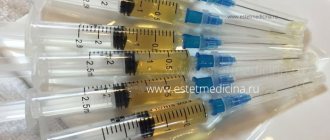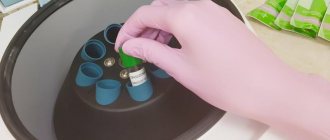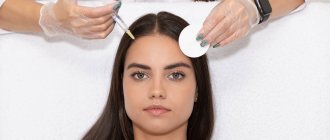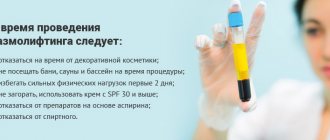From this article you will learn:
- What is the plasma lifting procedure?
- What are the indications and contraindications for the plasma lifting procedure?
- How to prepare for plasma lifting
- What are the stages of the plasma lifting procedure?
- Are there possible side effects from plasma lifting?
Currently, in order to look younger, remove wrinkles and age spots from the skin, it is not at all necessary to use foreign drugs and resort to surgical interventions. The body receives help through injections of blood plasma. This method, developed recently, is called plasma lifting, the effect of which has already been appreciated by a large number of people. Injections done during the course activate blood circulation, promote rapid restoration of tissues and metabolic processes of the skin in general.
What is plasmolifting of the face
Plasmolifting of the face is a modern method of skin rejuvenation and regeneration, which is carried out without surgical manipulation. This procedure is not dangerous, since it is carried out using the patient’s blood enriched with platelets, from which the plasma is separated and injected into problem areas.
Plasma “restarts” metabolic processes, resulting in increased production of:
- proteins (elastin, collagen);
- hyaluronic acid;
- stem cells;
- fibroblasts.
These elements are the main components for skin renewal; they restore youth, elasticity and beautiful appearance to it.
In order to obtain platelet autoplasma, the blood undergoes specialized treatment when exposed to a centrifuge.
Plasma is known to be rich in enzymes, hormones and vitamins. And since it is part of the patient’s own blood, there are no “foreign” components in its composition, therefore it is not rejected by the body and the positive effect of facial plasmolifting is obvious. This method is suitable for those who do not accept any chemical exposure to the skin and are afraid of the negative consequences that may be associated with it.
Read material on the topic: Plasmolifting of the face - a breakthrough in domestic cosmetology
Mechanism of action of plasma lifting
To use this method of cell regeneration, platelet autoplasma (TAP) is required. It does not contain red blood cells, and the number of platelets in it is close to their number in peripheral blood (150-350 thousand/μl). Such plasma is very rich in amino acids, mineral elements (potassium, magnesium, zinc, iron, calcium, etc., peptides and vitamins B, C, A, D, E, K, necessary for the life of cells. Being a natural component of the human body , autoplasma does not cause allergic reactions. This method is also universal due to its bioavailability, due to which regeneration processes occur naturally.
Physiologically, the process of plasmolifting occurs as follows: when platelets lose contact with the endothelium, leaving the capillaries and vessels, they change their shape and secrete alpha granules, which saturate the damaged area with growth factors.
The same thing happens in the plasmolifting procedure, when autoplasma is injected into the desired area, i.e. platelet adhesion and the release of growth factors from alpha granules occur, as in a normal protective physiological process.
Indications and contraindications for plasma lifting
Age-related aging of the skin is an indication for this procedure, naturally, at the request of the client. In most cases, women resort to it after 30–35 years, and the effect after plasma lifting at this age will already be noticeable. This operation can be performed at any age.
Don't forget that every person is unique. Therefore, a procedure that brought an extremely positive effect to one person may be completely ineffective for another. Accordingly, before plasma lifting it is necessary to go to an appointment with a specialist in the specialized field to identify indications for it.
Recommended articles on the topic:
- Microcurrent facial therapy - a beneficial procedure for your skin
- Beauty injections: types of drugs, reviews
- Placental therapy is the secret of eternal youth
A course of platelet autoplasma injections is recommended in the following cases:
- Decreased skin elasticity;
- Deterioration of the connective tissue fibers of the dermis;
- Small wrinkles;
- Sagging skin on the face;
- Peeling of the skin;
- Regeneration of the skin on the face after chemical or laser peeling;
- Acne;
- Consequences of sunburn.
This technique also has certain contraindications . Plasmolifting is prohibited if you have the following health problems:
- acute stage of chronic pathologies of internal organs;
- hepatitis;
- viral infections;
- diabetes;
- pustular and inflammatory dermatitis;
- blood diseases;
- cancer;
- mental disorders, depressive states;
- decreased immunity;
- low hemoglobin level;
- taking antibiotics and antacids;
- pregnancy and lactation.
Problems such as deep wrinkles and severe sagging of facial tissues cannot be solved by plasma lifting; its effectiveness will be too low; in this case, plastic surgery can help.
Read material on the topic: Laser facial skin rejuvenation: useful tips and recommendations
The essence of biorevitalization
Another injection procedure that helps restore youth to the face is biorevitalization. Hyaluronic acid is the main component of biorevitalization preparations; thanks to it, the skin becomes more hydrated and elastic, and recovers faster.
A little about hyaluronic acid
Hyaluronic acid keeps the skin hydrated because it retains moisture in its cells and creates an imperceptible protective film on the surface. Hyaluronic acid in the human body is found not only in the skin, but also in all other parts of it - in joints, bones, and nerve tissues. For the first time it was discovered in the eye, or rather in its vitreous body.
As a person ages, hyaluronic acid is removed from the body more actively, which leads to the appearance of wrinkles and sagging skin. 25 years is still a very young age, but by this time the formation of the element in the body slows down.
Contraindications
During a biorevitalization session, not pure hyaluronic acid is injected into the skin, but a drug based on it. Some components of this drug may cause an allergic reaction. Despite the fact that the likelihood of such an outcome is low, performing biorevitalization on people allergic to the components of hyauronate is unacceptable. Those who suffer from cancer and autoimmune diseases, pregnant and lactating women will also have to refuse biorevitalization. If there is damage to the facial skin, the procedure is also not performed.
Advantages and disadvantages of the plasma lifting procedure
The most important advantage of the procedure is the effect of rejuvenation of the face (or other part of the body); In addition, it can help get rid of baldness. The technique launches natural skin regeneration processes using “native” components - namely the patient’s blood plasma; it turns out that no foreign elements are involved in the process. That is why, with proper plasma lifting, any complications of an immune, allergic or other nature are practically absent.
"Against":
- In any case, microinjections are a medical intervention.
- If tubes and other equipment are reused, there is a risk of infection with serum infections, such as viral hepatitis.
- Activation of “dormant” infections (autoinfection). For example, if a person is a carrier of a virus, for example, herpes, which does not manifest itself in any way, but when plasma lifting is carried out, the virus awakens, as its habitat changes.
Read material on the topic: Facial mesotherapy procedure: pros and cons
Centrifuge and correctly selected centrifugation parameters
The centrifugation process cannot be too fast, otherwise the platelets will be damaged. It should also not be too slow, otherwise it will be impossible to properly separate the blood components.
Proper placement of the tubes is also important. Centrifuge tubes must be positioned horizontally because the centripetal force acts parallel to the long axis of the tube. In angled centrifuges, the tube is centrifuged at an angle of 20-30 degrees, and this already gives a worse effect.
Horizontal centrifuges cost twice as much as angular centrifuges, which is why most cosmetologists purchase angular devices. This reduces the cost of the procedure, while simultaneously reducing efficiency.
Preparation for the plasma lifting procedure
List of actions that must be performed before facial plasma lifting:
- Consultation with a specialist to determine indications, exclude contraindications and identify problem areas.
- Increasing the amount of fluid consumed 2-3 days before the date of the plasma lifting procedure, as well as on the day of its implementation.
- Reduce physical activity several days before the procedure.
- Usually the operation takes place in the morning, so a light breakfast is allowed. The day before plasma lifting, you should not drink alcohol, coffee, or spicy foods.
- If there are individual characteristics of the client, the specialist develops a separate program of preparation for the operation.
- Taking tests (if necessary).
Read material on the topic: Skin redermalization: all the pros and cons
Methodology for plasma lifting
The plasma lifting procedure consists of several stages; it can only be carried out by a clinic that has the appropriate permit to work with blood:
Stage 1. First of all, the face is disinfected, all contaminants are removed with a special product and wiped with chlorhexidine. Next, a thin layer of an anesthetic substance (cream or gel) is applied to the skin. The face is covered with film for a while so that the effect of anesthesia is longer and more reliable.
Stage 2. Collection of 20 to 40 ml of the client’s venous blood and its transfer into specially treated tubes.
Stage 3. The blood is placed in a specialized apparatus (medical centrifuge), where it is processed for 10 minutes. Upon completion, plasma with a large volume of platelets necessary for administration is released from the liquid. It is a loose, translucent yellowish liquid that is easily injected under the skin.
Stage 4. Blood plasma is placed in a sterile syringe, using which a specialist injects the face according to a certain pattern. Her choice depends on the type of skin problem. During the session, the needle is replaced to reduce the patient’s discomfort. After completing the procedure, the surface of the face is treated with saline solution, dried with napkins, then a soothing gel or Traumeel S is applied.
The duration of the procedure is approximately one hour. After this, the face swells a little, but in general you can safely go out “into society” without decorative cosmetics, since its use is temporarily prohibited. What effect you get from plasma lifting will largely depend on how seriously you take the restoration of your skin after surgery.
Read material on the topic: How to remove wrinkles on the face: the most effective methods
Plasma separation tube sets - right and wrong
The safety and effectiveness of plasma lifting depends on proper plasma preparation. The specialist should not use simple test tubes; only certified disposable kits should be used.
It is important to understand that the leukocyte-platelet layer between red blood cells and plasma is so thin that it is practically technically impossible to obtain without special equipment - profiled tubes with narrowings or a set of channels for separating plasma.
Plasmolifting
Recovery after plasma lifting
Rehabilitation is necessary to avoid complications from plasma lifting.
Rules of conduct for obtaining maximum effect:
- for the first 1-2 days, it is necessary to avoid contact of the face with anything (you cannot wash your face, apply makeup, or comb your hair if the procedure was performed on the scalp);
- It is forbidden to heat the treated area (visit a solarium, bathhouse, or be in the sun);
- if there is pain, you can apply a cool compress to your face without pressing hard on it;
- It is not recommended to do massage or other physical procedures on the treated area for the next few days;
- You should refrain from taking blood thinners and alcohol.
The number of plasma lifting procedures is determined by a cosmetologist. This depends on the following factors: the essence of the problem, the degree of its manifestation, the age of the patient, the primary condition of the skin. Typically the course ranges from 4 to 6 procedures. Between them you need a gap of 10–14 to 30 days. The result of plasma lifting is interesting when the effect of it is visible.
Read material on the topic: How to care for facial skin: home care and salon treatments
The effect of the plasma lifting procedure
As a result of plasma lifting, the effect after the first procedure may not be so pronounced. However, a few days after it, you can notice a positive trend. The point is that the result is cumulative, since blood plasma enriched with platelets works in the tissues even after the end of the session.
Whether there is any benefit from a full course of plasma lifting can be determined by the following signs:
- After a short period of time, facial wrinkles disappear, then deeper wrinkles are smoothed out, as a result, the face looks much younger.
- The elasticity of the skin is restored due to the activation of cell division of the collagen and elastin layers, it looks toned and healthy.
- Plasmolifting of the face, the task of which was to get rid of acne, normalizes the functioning of the sebaceous glands. Effect – the skin is cleared of acne, new acne does not form.
- Dark circles under the eyes disappear, crow's feet are leveled out.
- Microcracks heal, which provoke various inflammations and thinning of the skin. It becomes denser and takes on a more toned appearance.
- The level of moisture and nutrients increases, which leads to the disappearance of dryness, flaking and itching.
- The microrelief and color of the skin becomes smoother. The effect of facial plasmolifting, which is aimed at getting rid of acne, is not only to remove the acne itself, but also the consequences of it.
- As a result of plasma lifting, hyperpigmentation that was caused by prolonged exposure to the sun or other reasons is eliminated. Along with this positive effect, skin tightening often occurs.
- Another beneficial effect is the lightening and smoothing of scars. This occurs due to the involvement of skin resources in the regeneration.
Information about plasma lifting, its effect, and patient reviews can be found on the Internet.
Read material on the topic: How to shape the contour of the face: all possible ways
Plasma therapy for the face: pros and cons
Plasma therapy for the face: pros and cons
Plasma therapy for the face is far from the most famous procedure in aesthetic medicine, but it is one of the most effective. The main advantage that sets it apart from others is its absolute naturalness. After all, to rejuvenate and improve the skin, the body’s own resources are used – the patient’s blood plasma. Expert Clinics services Plasma therapy for the face Plasma therapy for the face is cellular rejuvenation that starts from the inside. Plasma therapy for the face Plasma therapy for hair Plasma therapy for hair, or PRP therapy, is one of the innovative methods that allows you to naturally restore hair and improve its quality. Plasma therapy for hair Plasmolifting of intimate zones Plasmolifting of intimate zones is a unique technology for rejuvenation and healing of tissues using plasma from your own blood. Plasmolifting of intimate areas Call me back But before choosing plasma therapy as a way to preserve beauty, it is important to evaluate all the pros and cons of this technique. What is facial plasma therapy? Plasma therapy, or PRP therapy, is an innovative procedure developed by Russian scientists. It is used in various fields of medicine - both for treatment and for rehabilitation after serious illnesses. This innovative development, which does not require the use of expensive drugs, is also in demand in cosmetology. The idea is that plasma saturated with platelets is injected under the skin using injections - they release growth factors that help restore tissue from the inside. Regeneration occurs thanks to the intensive production of stem cells, collagen and hyaluronic acid. PRP therapy is recommended for the following aesthetic problems: Skin hyperpigmentation; Flabbiness and decreased elasticity; Dull complexion; Wrinkles (facial and age-related); Cuperosis (vascular network); Acne and other rashes; Psoriasis and other dermatological pathologies. It is important to be in good health at the time of the procedure so that the plasma is as beneficial as possible. Therefore, plasma therapy has a number of contraindications: Current use of antibiotics; Oncological pathologies; Flu and viral infections; Decreased immunity; Hepatitis; Blood diseases and bleeding disorders; Chronic diseases in the acute stage; Mental disorders; Autoimmune thyroid diseases; Rheumatoid arthritis; Menstruation; Pregnancy and lactation period. If, in addition to antibiotics, the patient is taking any medications, it is necessary to consult with a doctor about whether they should be discontinued some time before the plasma therapy session. And, in any case, a few days before the procedure, you need to exclude fatty, fried, salty, and alcohol from your diet. At the same time, you need to drink as much water as possible. Facial plasma therapy is done on an empty stomach. And for two weeks after the session it is recommended to refrain from visiting the bathhouse or solarium. Also, do not swim in ponds or pools. Pros of plasma therapy Like every aesthetic procedure, plasma therapy has its own advantages and disadvantages. The advantages include: Naturalness and safety of the process. This anti-aging technique involves using only the patient's plasma. The quality of the skin noticeably improves: tone is evened out, hydration and elasticity increase, which helps slow down the aging process. Effectively copes with acne and post-acne. Plasma therapy also “erases” pigment spots. The face becomes significantly younger due to the fact that the oval is tightened and the contours are improved. In addition, puffiness goes away and circles under the eyes disappear, which give any person an haggard appearance, adding years to his real age. The technique can be combined with other anti-aging procedures. Used for rehabilitation after chemical peelings and laser resurfacing. The tissues are saturated with oxygen, and elastin and collagen begin to be produced more intensively. Allergic reactions are excluded, since the patient's own blood is used. The effect is noticeable after the first session. No rehabilitation is required and side effects are minimal. The results last a long time. If you complete the full course of procedures, the rejuvenating effect can last up to two years. Sign up for a consultation Disadvantages of plasma therapy As you can see, PRP therapy has an impressive number of advantages. However, there are also disadvantages that are important to consider before deciding to undergo plasma injections. The disadvantages are: Swelling and bruising at the injection sites. This is a consequence characteristic of many procedures that prolong youth. But, as a rule, all traces disappear within a few days. However, if the patient has sensitive skin, bruising and redness may last longer. There may be soreness. Generally, people with a low pain threshold may experience discomfort during the procedure. One procedure will not give a lasting effect - a course of procedures is necessary. Their number is prescribed by the doctor. On older faces the effect will not be convincing. The most pleasant results are usually obtained by patients aged 30-40 years. The procedure should only be performed by an experienced doctor who follows all the rules of anesthesia and blood preparation. Otherwise, infection and complications may occur. Quite a high cost of the procedure. Despite the fact that no drugs are used during plasma rejuvenation, the price for manipulation is no lower than for numerous “beauty injections”. The patient may be disappointed with the result. True, in the event that he violates the training rules. Despite some disadvantages, PRP therapy is an effective and safe procedure that is gaining popularity. Many patients note that their face becomes smoother, firmer and more rested. Rashes disappear and wrinkles become less pronounced. At the same time, the skin stops peeling and glows with health. But it must be taken into account that plasma therapy will not be able to transform a patient who ignores the preparation rules. And it’s not just about observing dietary restrictions. It is advisable to undergo tests before the procedure, which will “tell” about the person’s current state of health. The doctor will advise which ones after consultation. And, of course, it is important to find a competent doctor who can choose the optimal treatment strategy. Reviews about the procedure Svetlana, 31 years old: “I’m 31 years old, due to poor eyesight I often squint – hence the “crow’s feet” around my eyes. But there are already signs of aging - the cheeks have “sank” down, the oval of the face is no longer clear. I also have blackheads, enlarged pores and mixed skin: my nose and forehead are shiny, but the rest of the areas are flaky. When I came to the cosmetologist with all this set of problems, she advised me to start with plasma therapy. In the end, I did three procedures. The first one was a little painful, but after two weeks the nasolabial folds seemed to smooth out, the cheeks tightened, and the skin became softer. During the second procedure, it was no longer so painful, and after a week the face was well tightened, there were fewer rashes, and the skin was well hydrated. The third procedure was generally easy to endure, and the result became even more noticeable - I looked rested and rejuvenated. True, the bruises lingered for several days after the sessions, but it’s not scary - the result is worth it.” Irina, 44 years old: “I chose plasma therapy instead of biorevitalization because naturalness is important to me. The absence of side effects is another plus that weighs in favor of plasma therapy. I had injections in my face and neck. It didn't hurt me. The injection marks disappeared after about 5 days. There is not much point in one procedure, so I went through three sessions. What is the result? I’ll say right away that at my age, wrinkles did not miraculously disappear, although they smoothed out a little; overall, the skin became more nourished and fresh. I receive compliments from my colleagues. But you have to understand that this is not radical rejuvenation when you are over 40, but a good recharge.” Galina, 38 years old: “I’m terribly afraid of surgery and harsh chemical peels, so I’m looking for the most gentle methods to maintain beauty. After searching through information on the Internet, I chose plasma therapy. The doctor took 4 tubes of blood from me and the plasma that was obtained from them was enough for my face and neck. Injections are given mainly where the facial muscles are attached. I went through several sessions and was generally pleased with the results; the skin became velvety and smoother. Now I’m thinking about doing plasma rejuvenation of the décolleté area.” Oksana, 35 years old: “According to my feelings, the procedure is effective. Plasma therapy suited me 100%: fine wrinkles smoothed out, my skin glowed. And this is after one procedure. Of course, to consolidate the result, you need to take a course prescribed by your doctor. By the way, my friend became covered in spots after such a session. So, everything is individual." Angelina, 32: “It is very important before the plasma therapy procedure to make sure that your doctor has undergone special training - feel free to ask for supporting certificates. If everything is in order, the result will be, and no side effects will upset you. I carefully chose the clinic and the doctor, and I am pleased with the result. After 4 days, there were no traces of the injections left, and the skin became nourished, smooth, and the rashes that appear every month during my “critical days” disappeared. I saw the effect about a week after the first procedure. I will continue and get better!”
2020-08-29
2022-01-14
Expert Clinics
Expert Clinics
Does plasma lifting cause side effects?
One of the most popular questions: does facial plasma lifting have side effects? Indeed, it is considered a relatively safe procedure, but some complications can still arise. Therefore, you should be aware of these and know how you can avoid them.
Thus, this procedure is considered hypoallergenic, but there is a risk of an allergic reaction (albeit with a low probability), in particular, it can be to the metals from which the needles are made, and to drugs added to the blood to prevent the blood from clotting (anticoagulants ).
Such allergic reactions can be expressed in the form of swelling and redness of the skin, small bruises in the area where the drug was administered (hematoma). It is worth noting that they go away on their own in about a week.
Another more dangerous side effect is infection of the blood during donation for further centrifugation. A strong immune system can cope with this problem, but with a weakened immune system, suppuration may occur at the injection site. Naturally, theoretically, there is a possibility of more serious consequences of blood poisoning. According to statistics, there are practically no such cases, because the occurrence of unpleasant effects of this level directly depends on the clinic and the experience of the medical staff.
In the presence of acne of an infectious nature, an exacerbation of the disease may occur within a month after the plasma lifting procedure, and the effect occurs even later.
Another side effect of this procedure, which is related to blood, can occur with repeated use of the blood processing machine, as infection can be transferred from the blood of one client to the blood of another. But in order to allow such a complication, the clinic must not care at all about its reputation.
There is also a possibility of developing pigmentation, but this situation can be considered more of a side effect than a complication, and it can be easily avoided by not visiting saunas, swimming pools, solariums, or being in the open sun.
List of other possible unpleasant effects and problems:
- Worsening of chronic diseases;
- Autosensitization;
- Accelerated fibrosis;
- Short-term results.
An alternative to plasma lifting can be volumetric plastic surgery, which restores the elasticity and turgor of the skin through autoimplants made from the client’s fatty tissue. However, such a procedure is not a rejuvenation or a facelift; it only restores volume and has a completely different effect.
Your biggest problem may be contacting a clinic that does not have a specialized license and experienced cosmetologists on its staff. The effect of plasma lifting in this case is unlikely to please you.
To summarize this article, we will name all the pros and cons of plasma lifting, and also clarify how long the effect of it lasts.
Read material on the topic: Face building for the face
How often can you do plasmolifting of the face?
Everything is very individual. The quality of plasma lifting performed and how long the effect lasts depends on many factors, such as the initial condition of the skin, its characteristics, and the natural speed of recovery.
So is there any point in the plasma lifting procedure? It is known that the effect lasts for at least one year (more precisely, from one to two years), but to consolidate it, repeated maintenance procedures are recommended - usually from four to six, depending on the doctor’s prescription.
The frequency of plasma lifting is twice a year. Before deciding to undergo this procedure, study in detail the information about facial plasma lifting, understand what effect you want to get from it and study the possible risks.
Keep in mind that the resorption time of the injected material is individual, which means that only a specialist can prescribe a repeat procedure.
Nowadays, you no longer have to spend a lot of time performing complex and unpleasant self-care procedures at home. It is much easier to seek help from real professionals - the Veronika Herba beauty and health center, equipped with effective and modern equipment.
Why clients choose Veronika Herba Beauty and Health Center:
- This is a beauty center where you can take care of yourself at a reasonable cost, while your face and/or body will be treated not by an ordinary cosmetologist, but by one of the best dermatologists in Moscow. This is a completely different, higher level of service!
- You can receive qualified help at any time convenient for you. The beauty center is open from 9:00 to 21:00, seven days a week. The main thing is to agree with your doctor in advance on the date and time of your appointment.
Sign up for a consultation with a specialist by phone +7 (495) 085-15-13
, and you will see for yourself!
Skin care
Whatever rejuvenation technique is chosen, it is necessary to follow the rules for skin care after the procedure.
Rubbing your face with a chlorhexidine solution or another disinfectant recommended by a cosmetologist will help prevent infection. On the contrary, visiting swimming pools, saunas, baths is not recommended, because the risk of harmful bacteria getting into wounds in such establishments increases. Tanning in a solarium or sunbathing after a rejuvenation session can cause age spots to appear, so use sunscreen before going outside on a sunny day.
Sometimes after biorevitalization, noticeable marks from punctures appear on the face, they are called petechiae. They usually disappear quickly, but if petechiae remain on the skin for too long, it is necessary to apply a special product to the skin every few hours. A specialist will tell you whether it is necessary.











